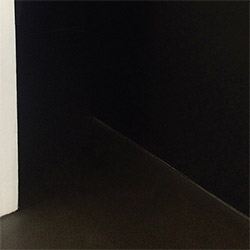
Where much music places the composer, their vision and their efforts to clarify every scratch on the page the center of the universe, John Cage eschewed the authoritative narrative — particularly in his latter-years — to promote a natural, not strict, order. It's like asking someone "be yourself" instead of forcing them to smile or act in front of a camera while also offering a pep talk to influence the desired result. Further, though, the goal is to "insert the individual into the current in which everything passes."
Having previously reimagined Prokofiev, Le Sacre du printemps and Bartók's Mikrokosmos, the Quartetski collective aim their talents at Cage's FOUR6, an aleatoric process focused on the initial selection of twelve sounds with "fixed characteristics (amplitude, overtone, structure etc.)" These are progressed per several time brackets found on the player's scores (each player has a different sheet); a diagonal line connecting multiple time brackets indicates that interactions should occur more frequently.
The realization here by Isaiah Ceccarelli on percussion and synthesizer, Philippe Lauzier on bass clarinet and synthesizer, guitarist Bernard Falaise, and Pierre-Yves Martel on electric bass is, not surprisingly based on the oeuvre of these four gentlemen, is incredibly sensitive, reverent, a feeling of patient conjuring without the intent of finishing anything to term. Stepping into the "For any way of producing sounds" directions, the group adopts a loose focus on the lugubrious: a deep bass clarinet tone with a pleasing intro and bratty overblown honk is enlarged with an amplified bass note, which subsequently fills the speakers; arrhythmic taps on metal played to technically be defined as "sustained"; Falaise gently wringing his guitar's neck into earthquake tremors. The synthetic sounds range from ruminating, dripping blobs one associates with modular synthesizer, musically complete textural environments, and "sour" organ prelude in the vein of Kali Malone and FUJI|||||||||||TA.
Seemingly intentional, a good number of Cage interpretations purposefully translate as sunny and mild-mannered as the man's spirited laughter and smile, Quartetski's FOUR6 is tense and spooky. Some of the twelve sounds involve (satisfying) electric guitar extended techniques and aforementioned warbling synthesizer gestures; even the cooing bass clarinet tags the end of long, passive sustained notes with a bratty overblown hiccup. I was immediately struck with how it crawls in the same ritualistic way and sonically (timbre) echoes Stockhausen's 1968 work Aus den sieben Tagen, a piece whose text-based score provides details to guide the player to "Intuitive music" ("instant creation in which fixed principles or rules may or may not have been given"). That work exudes a mysterious sinisterness where it's unclear if one should run or grab a blanket; am I hearing creation or prolonged destruction of the universe? It is sublimity — in the truest sense of the word — and the furrowed brow with intent stare of Stockhausen.
Per Cage's side-bar on FOUR6: "When performed as a solo, the first player's part is used and the piece is called ONE7." Per Quartetski (Martel): "For any pitched instrument able to play sustained notes...each player derives a chromatic tone row obtained using chance operations." Though obviously not a solo, this second work holds to Lauzier's (player one) initial bass clarinet gesture as the other three members restrict their movements and in turn have less accidental exchanges (i.e. happenstance chords) than the previous piece. Instead of slightly deviating as on FOUR6, the formal connection now seems both united and independent with each player supporting and handing off the same line in a Klangfarbenmelodie fashion. The long notes move like rock climbing where the lead carefully scales, thoughtfully pauses to set a purchase for those below who are also working to keep the first guy secure, repeat until finished all while holding the same rope/lead.
The lesson one learns from Cage — when performing Cage — is that the freedom implied from a lack of dynamics, instrumentation etc. on the page can become an unforgivable obstacle in the conservative musician's mind. When my undergraduate score analysis class was presented with one of the man's works (missing the instructions and author's name), we stared intently for an hour trying to envision how a performance of graphs and squiggly numbers could hold interest to anyone. Based on Quartetski's endeavors, the problem was we 18th Century harmony, cadence and meter-obsessed students. Cage's is as elegant as those playing and respecting it. Quartetski just happens to be naturally photogenic.
Comments and Feedback:
|



